Estimation of Co-Seismic Surface Deformation Induced by 24 September 2019 Mirpur, Pakistan Earthquake along an Active Blind Fault Using Sentinel-1 TOPS Interferometry
Abstract
:1. Introduction
1.1. Geology and Tectonic Settings
1.2. Study Area
2. Materials and Methods
2.1. InSAR Processing
2.2. Co-Seismic Interferometric Phase
3. Results
3.1. LOS Displacement
3.2. Offset Tracking
3.3. Ground Faulting and Deformation
4. Discussion
Time Series Analysis for LOS Displacement
5. Conclusions
Author Contributions
Funding
Data Availability Statement
Conflicts of Interest
References
- Giménez, J.; Borque, M.; Gil, A.J.; Alfaro, P.; Estévez, A.; Surinach, E. Comparison of long-term and short-term uplift rates along an active blind reverse fault zone (Bajo Segura, Se Spain). Stud. Geophys. Geod. 2009, 53, 81–98. [Google Scholar] [CrossRef]
- Ganas, A.; Valkaniotis, S.; Briole, P.; Serpetsidaki, A.; Kapetanidis, V.; Karasante, I. Domino-style earthquakes along blind normal faults in Northern Thessaly (Greece): Kinematic evidence from field observations, seismology, SAR interferometry and GNSS. Bull. Geol. Soc. Greece 2021, 58, 37–86. [Google Scholar] [CrossRef]
- Ollarves, R.; Audemard, F.; Carlota, L.C.M. Morphotectonic Criteria for the Identification of Active Blind Faulting in Alluvial Environments: Case Studies from Venezuela and Colombia. Z. Für Geomorphol. 2006, 145, 81–103. [Google Scholar]
- Sithu, K.; Khaing, S. Structural Deformation along the Active Sagaing Fault Zone Between Sagaing and Mingun Area, Central Myanmar. In Proceedings of the Asia Oceania Geosciences Conference, Singapore, 6–11 August 2017. [Google Scholar]
- He, P.; Wen, Y.; Xu, C.; Chen, Y. High-quality three-dimensional displacement fields from new-generation SAR imagery: Application to the 2017 Ezgeleh, Iran, earthquake. J. Geod. 2019, 93, 573–591. [Google Scholar] [CrossRef]
- Yang, Y.; Chen, Q.; Xu, Q.; Zhang, Y.; Yong, Q.; Liu, G. Coseismic surface deformation of the 2014 Napa earthquake mapped by Sentinel-1A SAR and accuracy assessment with COSMO-SkyMed and GPS data as cross validation. Int. J. Digit. Earth 2017, 10, 1197–1213. [Google Scholar] [CrossRef]
- Keren, D. Integration of New Generation SAR Data for Extracting the Earth’s Surface Topography and Displacement: Methodology and Modelling. Acta Geod. Cartogr. Sin. 2018, 47, 422. [Google Scholar]
- Chang, X.-T.; Jinyun, G.; Zhang, Y.-H.; Wang, X.-Q. On the application of DInSAR to deformation monitoring in desert areas. Appl. Geophys. 2011, 8, 86–93. [Google Scholar] [CrossRef]
- Bayik, C. Deformation analysis of 2020 mw 5.7 Karlıova, Turkey, earthquake using DInSAR method with different incidence angle SAR data. Arab. J. Geosci. 2021, 14, 273. [Google Scholar] [CrossRef]
- Carboni, F.; Porreca, M.; Valerio, E.; Mariarosaria, M.; De Luca, C.; Azzaro, S.; Ercoli, M.; Barchi, M.R. Surface ruptures and off-fault deformation of the October 2016 central Italy earthquakes from DInSAR data. Sci. Rep. 2022, 12, 3172. [Google Scholar] [CrossRef]
- Maqsood, T.; Schwarz, J. Estimation of Human Casualties from Earthquakes in Pakistan--An Engineering Approach. Seismol. Res. Lett. 2011, 82, 32–41. [Google Scholar] [CrossRef]
- Mahmood, I.; Kidwai, A.A.; Qureshi, S.N.; Iqbal, M.F.; Atique, L. Revisiting major earthquakes in Pakistan. Geol. Today 2015, 31, 33–38. [Google Scholar] [CrossRef]
- Pasari, S.; Sharma, Y. Contemporary earthquake hazards in the West-northwest Himalaya: A statistical perspective through natural times. Seism. Res. Lett. 2020, 91, 3358–3369. [Google Scholar] [CrossRef]
- Shah, S.U.; Shafique, M.; Basharat, M.; Chen, X. Evaluating susceptibility of the 2005 earthquake produced landslides in Kashmir region, Northern Pakistan. J. Himal. Earth Sci. 2019, 52, 83. [Google Scholar]
- Ahmad, N.; Barkat, A.; Ali, A.; Sultan, M.; Rasul, K.; Iqbal, Z.; Iqbal, T. Investigation of spatio-temporal satellite thermal IR anomalies associated with the Awaran earthquake (Sep 24, 2013; M 7.7), Pakistan. Pure Appl. Geophys. 2019, 176, 3533–3544. [Google Scholar] [CrossRef]
- Pararas-Carayannis, G. The potential of tsunami generation along the Makran Subduction Zone in the northern Arabian Sea: Case study: The earthquake and tsunami of November 28, 1945. Sci. Tsunami Hazards 2006, 24, 358–384. [Google Scholar]
- Shah, S.T.; Özacar, A.A.; Gülerce, Z. Fault-based probabilistic seismic hazard assessment of the eastern Makran subduction and the Chaman transform fault, Pakistan: Emphasis on the source characterization of megathrust. J. Asian Earth Sci. 2021, 205, 104604. [Google Scholar] [CrossRef]
- Jouanne, F.; Awan, A.; Madji, A.; Pêcher, A.; Latif, M.; Kausar, A.; Mugnier, J.L.; Khan, I.; Khan, N.A. Postseismic deformation in Pakistan after the 8 October 2005 earthquake: Evidence of afterslip along a flat north of the Balakot-Bagh Thrust. J. Geophys. Res. 2011, 116, B7. [Google Scholar] [CrossRef]
- USGS. M 5.4—7km SSE of New Mirpur, Pakistan; National Earthquake Information Center: Denver, CO, USA, 2019.
- NDMA. NDMA Situation Report No. 11—Mirpur Earthquake 2019; Government of Pakistan: Islamabad, Pakistan, 2019.
- García Sánchez, A.J. Application of differential synthetic aperture radar interferometry (DINSAR) to the monitoring of ground and structure movements. Caminos 2019. [Google Scholar]
- Jia, H.; Wang, Y.; Ge, D.; Deng, Y.; Wang, R. Improved offset tracking for predisaster deformation monitoring of the 2018 Jinsha River landslide (Tibet, China). Remote Sens. Environ. 2020, 247, 111899. [Google Scholar] [CrossRef]
- Li, X.; Jónsson, S.; Cao, Y. Interseismic deformation from sentinel-1 burst-overlap interferometry: Application to the southern Dead Sea fault. Geophys. Res. Lett. 2021, 48, e2021GL093481. [Google Scholar] [CrossRef]
- Budillon, A.; Gierull, C.H.; Pascazio, V.; Schirinzi, G. Along-track interferometric SAR systems for ground-moving target indication: Achievements, potentials, and outlook. IEEE Geosci. Remote Sens. Mag. 2020, 8, 46–63. [Google Scholar] [CrossRef]
- Ali, M.; Shahzad, M.I.; Nazeer, M.; Mahmood, I.; Zia, I. Estimation of surface deformation due to Pasni earthquake using RADAR interferometry. Geocarto Int. 2019, 36, 1630–1645. [Google Scholar] [CrossRef]
- Ali, M.; Shahzad, M.I.; Nazeer, M.; Kazmi, J. Estimation of surface deformation due to pasni earthquake using sar interferometry. ISPRS-Int. Arch. Photogramm. Remote Sens. Spat. Inf. Sci. 2018, XLII-3, 23–29. [Google Scholar] [CrossRef]
- Ramzan, U.; Fan, H.; Aeman, H.; Ali, M.; Al-qaness, M.A.A. Combined analysis of PS-InSAR and hypsometry integral (HI) for comparing seismic vulnerability and assessment of various regions of Pakistan. Sci. Rep. 2022, 12, 22423. [Google Scholar] [CrossRef] [PubMed]
- Ali, M.; Afzal, Z.; Budillon, A.; Ferraioli, G.; Hussain, S.; Schirinzi, G. Pakistan Earthquake Study Using Sentinel-1 Tops Interferometry. In Proceedings of the IGARSS 2023—2023 IEEE International Geoscience and Remote Sensing Symposium, Pasadena, CA, USA, 16–21 July 2023; pp. 2181–2184. [Google Scholar]
- Yang, C.; Han, B.; Zhao, C.; Du, J.; Zhang, D.; Zhu, S. Co-and post-seismic deformation mechanisms of the MW 7.3 Iran earthquake (2017) revealed by Sentinel-1 InSAR observations. Remote Sens. 2019, 11, 418. [Google Scholar] [CrossRef]
- Mughal, M.S.; Zhang, C.; Du, D.; Zhang, L.; Mustafa, S.; Hameed, F.; Khan, M.R.; Zaheer, M.; Blaise, D. Petrography and provenance of the Early Miocene Murree Formation, Himalayan Foreland Basin, Muzaffarabad, Pakistan. J. Asian Earth Sci. 2018, 162, 25–40. [Google Scholar] [CrossRef]
- Iqbal, O.; Baig, M.S.; Pervez, S.; Siddiqi, M.I. Structure and stratigraphy of Rumbli and Panjar areas of Kashmir and Pakistan with the aid of GIS. J. Geol. Soc. India 2018, 91, 57–66. [Google Scholar] [CrossRef]
- Iqbal, O.; Ahmad, M.; Kadir, A. Effective Evaluation of Shale Gas reservoirs by Means of an Integrated Approach to Petrophysics and Geomechanics for the Optimization of Hydraulic Fracturing: A case Study of the Permian Roseneath and Murteree Shale Gas Reservoirs, Cooper Basin, Australia. J. Nat. Gas Sci. Eng. 2018, 58, 34–58. [Google Scholar] [CrossRef]
- Khan, M.Y.; Turab, S.A.; Riaz, M.S.; Atekwana, E.A.; Muhammad, S.; Butt, N.A.; Abbas, S.M.; Zafar, W.A.; Ohenhen, L.O. Investigation of coseismic liquefaction-induced ground deformation associated with the 2019 Mw 5.8 Mirpur, Pakistan, earthquake using near-surface electrical resistivity tomography and geological data. Near Surf. Geophys. 2021, 19, 169–182. [Google Scholar] [CrossRef]
- Talha Qadri, S.; Shah, A.A.; Sahari, S.; Raja, A.; Yaghmaei-Sabegh, S.; Khan, M.Y. Tectonic geomorphology-based modeling reveals dominance of transpression in Taxila and the contiguous region in Pakistan: Implications for seismic hazards. Model. Earth Syst. Environ. 2023, 9, 1029–1050. [Google Scholar] [CrossRef]
- Awais, M.; Qasim, M.; Tanoli, J.I.; Ding, L.; Sattar, M.; Baig, M.S.; Pervaiz, S. Detrital Zircon Provenance of the Cenozoic Sequence, Kotli, Northwestern Himalaya, Pakistan; Implications for India–Asia Collision. Minerals 2021, 11, 1399. [Google Scholar] [CrossRef]
- Raza, S.I.; Naqash, T. Quake shakes AJK, Punjab & KP; 25 killed in Mirpur. DAWN, 25 September 2019. [Google Scholar]
- Sana, H.; Nath, S. In and Around the Hazara-Kashmir Syntaxis: A Seismotectonic and Seismic Hazard perspective. J. Indian Geophys. Union 2016, 20, 496–505. [Google Scholar]
- Ali, A.; Tanveer, M.U.; Munawar, R.K.; Rehman, S.-U.; Aslam, I.; Tanver, G.; Mahmood, S.A. Investigation of Surface Deformation in Lower Jehlum Valley and Eastern Potwar using SRTM DEM. Int. J. Innov. Sci. Technol. 2019, 2, 17–30. [Google Scholar]
- Mahmood, A.; Qureshi, R.A.; Mahmood, A.; Sangi, Y.; Shaheen, H.; Ahmad, I.; Nawaz, Z. Ethnobotanical survey of common medicinal plants used by people of District Mirpur, AJK, Pakistan. J. Med. Plant Res. 2011, 5, 4493–4498. [Google Scholar]
- Rafique Mir, K. Cesium-137 activity concentrations in soil and brick samples of Mirpur, Azad Kashmir; Pakistan. Iran. J. Radiat. Res. 2014, 12, 39–46. [Google Scholar]
- Iqbal, A.; Baig, M.; Akram, M.; Kazmi, A.; Saleem, S.; Qureshi, A. Radon Levels in Dwellings of New Mirpur Azad Kashmir, Sub-Himalayas, Pakistan. Indoor Built Environ. 2008, 17, 397–402. [Google Scholar] [CrossRef]
- Berardino, P.; Fornaro, G.; Lanari, R.; Sansosti, E. A new algorithm for surface deformation monitoring based on small baseline differential SAR interferograms. IEEE Trans. Geosci. Remote Sens. 2002, 40, 2375–2383. [Google Scholar] [CrossRef]
- Lanari, R.; Casu, F.; Manzo, M.; Zeni, G.; Berardino, P.; Manunta, M.; Pepe, A. An Overview of the Small BAseline Subset Algorithm: A DInSAR Technique for Surface Deformation Analysis. Deform. Gravity Change Indic. Isostasy Tecton. Volcanism Clim. Change 2007, 164, 637–661. [Google Scholar]
- Xu, H.P.; Zhu, L.F.; Liu, X.H.; Chen, Y.F. A novel baseline estimation approach of spaceborne InSAR based on interferometric fringe frequency. Dianzi Xuebao 2011, 39, 2212–2217. [Google Scholar]
- Elias, P.; Ganas, A.; Briole, P.; Parcharidis, I.; Avallone, A.; Roukounakis, N.; Panagiotis, A.; Marine, R.; Daniele, C.; Cristiano, T.; et al. Surface Deformation due to the M6.5 Lefkada Earthquake (17 November 2015) Exploiting SENTINEL-1 and GNSS Observations. Implications for Seismic Hazard. In Proceedings of the 19th EGU General Assembly, EGU2017, Vienna, Austria, 23–28 April 2017. [Google Scholar]
- Jiang, S.; Wang, B.; Xiang, M.; Fu, X.; Sun, X.; Hu, X.; Qian, Q. The Method of the InSAR/INS Integrated Navigation Based on Fringe Matching. Tien Tzu Hsueh Pao/Acta Electron. Sin. 2017, 45, 2832–2841. [Google Scholar]
- Goldstein, R.M.; Werner, C.L. Radar interferogram filtering for geophysical applications. Geophys. Res. Lett. 1998, 25, 4035–4038. [Google Scholar] [CrossRef]
- Bhattacharya, A.; Arora, M.K.; Sharma, M.L. Usefulness of synthetic aperture radar (SAR) interferometry for digital elevation model (DEM) generation and estimation of land surface displacement in Jharia coal field area. Geocarto Int. 2012, 27, 57–77. [Google Scholar] [CrossRef]
- Suo, Z.; Zhang, J.; Li, M.; Zhang, Q.; Fang, C. Improved InSAR phase noise filter in frequency domain. IEEE Trans. Geosci. Remote Sens. 2016, 54, 1185–1195. [Google Scholar] [CrossRef]
- Osmanoglu, B.; Dixon, T.H.; Wdowinski, S. Three-dimensional phase unwrapping for satellite radar interferometry, I: DEM generation. IEEE Trans. Geosci. Remote Sens. 2014, 52, 1059–1075. [Google Scholar] [CrossRef]
- Bechor, N.B.; Zebker, H.A. Measuring two-dimensional movements using a single InSAR pair. Geophys. Res. Lett. 2006, 33, 16. [Google Scholar] [CrossRef]
- Macchiarulo, V.; Milillo, P.; Blenkinsopp, C.; Giardina, G. Monitoring deformations of infrastructure networks: A fully automated GIS integration and analysis of InSAR time-series. Struct. Health Monit. 2022, 21, 1849–1878. [Google Scholar] [CrossRef]
- Aimaiti, Y.; Liu, W.; Yamazaki, F.; Maruyama, Y. Earthquake-induced landslide mapping for the 2018 Hokkaido Eastern Iburi earthquake using PALSAR-2 data. Remote Sens. 2019, 11, 2351. [Google Scholar] [CrossRef]
- Niraj, K.; Gupta, S.K.; Shukla, D. Kotrupi landslide deformation study in non-urban area using DInSAR and MTInSAR techniques on Sentinel-1 SAR data. Adv. Space Res. 2022, 70, 3878–3891. [Google Scholar] [CrossRef]
- Fadhillah, M.F.; Achmad, A.R.; Lee, C.-W. Improved combined scatterers interferometry with optimized point scatterers (ICOPS) for interferometric synthetic aperture radar (InSAR) time-series analysis. IEEE Trans. Geosci. Remote Sens. 2021, 60, 1–14. [Google Scholar] [CrossRef]
- Chen, Y.; Tong, Y.; Tan, K. Coal mining deformation monitoring using SBAS-InSAR and offset tracking: A case study of Yu County, China. IEEE J. Sel. Top. Appl. Earth Obs. Remote Sens. 2020, 13, 6077–6087. [Google Scholar] [CrossRef]
- Zhao, G.; Wang, L.; Deng, K.; Wang, M.; Xu, Y.; Zheng, M.; Luo, Q. An adaptive offset-tracking method based on deformation gradients and image noises for mining deformation monitoring. Remote Sens. 2021, 13, 2958. [Google Scholar] [CrossRef]
- Huang, Z.; Zhang, G.; Shan, X.; Gong, W.; Zhang, Y.; Li, Y. Co-seismic deformation and fault slip model of the 2017 Mw 7.3 Darbandikhan, Iran–Iraq earthquake inferred from D-InSAR measurements. Remote Sens. 2019, 11, 2521. [Google Scholar] [CrossRef]
- Mastro, P.; Serio, C.; Masiello, G.; Pepe, A. The multiple aperture SAR interferometry (MAI) technique for the detection of large ground displacement dynamics: An overview. Remote Sens. 2020, 12, 1189. [Google Scholar] [CrossRef]
- He, P.; Wen, Y.; Xu, C.; Chen, Y. Complete three-dimensional near-field surface displacements from imaging geodesy techniques applied to the 2016 Kumamoto earthquake. Remote Sens. Environ. 2019, 232, 111321. [Google Scholar] [CrossRef]
- Li, S.; Leinss, S.; Hajnsek, I. Cross-correlation stacking for robust offset tracking using SAR image time-series. IEEE J. Sel. Top. Appl. Earth Obs. Remote Sens. 2021, 14, 4765–4778. [Google Scholar] [CrossRef]
- Liu, X.; Zhao, C.; Zhang, Q.; Lu, Z.; Li, Z. Deformation of the Baige landslide, Tibet, China, revealed through the integration of cross-platform ALOS/PALSAR-1 and ALOS/PALSAR-2 SAR observations. Geophys. Res. Lett. 2020, 47, e2019GL086142. [Google Scholar] [CrossRef]
- Anantrasirichai, N.; Biggs, J.; Albino, F.; Hill, P.; Bull, D. Application of Machine Learning to Classification of Volcanic Deformation in Routinely Generated InSAR Data. J. Geophys. Res. Solid Earth 2018, 123, 6592–6606. [Google Scholar] [CrossRef]
- Zhao, D.; Qu, C.; Shan, X.; Bürgmann, R.; Chen, H.; Wu, D.; Gong, W. Post-seismic deformation of the 2008 Wenchuan earthquake reveals a misaligned rheological boundary in the lower crust along the eastern Tibetan Plateau margin. Geophys. J. Int. 2023, 235, 1353–1372. [Google Scholar] [CrossRef]
- Khan, S.D.; Chen, L.; Ahmad, S.; Ahmad, I.; Ali, F. Lateral structural variation along the Kalabagh Fault Zone, NW Himalayan foreland fold-and-thrust belt, Pakistan. J. Asian Earth Sci. 2012, 50, 79–87. [Google Scholar] [CrossRef]
- Karakostas, V.; Papazachos, C.; Papadimitriou, E.; Foumelis, M.; Kiratzi, A.; Pikridas, C.; Kostoglou, A.; Kkallas, C.; Chatzis, N.; Bitharis, S.; et al. The March 2021 Tyrnavos, central Greece, doublet (Μw6. 3 and Mw6. 0): Aftershock relocation, faulting details, coseismic slip and deformation. Bull. Geol. Soc. Greece 2021, 58, 131–178. [Google Scholar] [CrossRef]
- Moro, M.; Saroli, M.; Stramondo, S.; Bignami, C.; Albano, M.; Falcucci, E.; Gori, S.; Doglioni, C.; Polcari, M.; Tallini, M.; et al. New insights into earthquake precursors from InSAR. Sci. Rep. 2017, 7, 12035. [Google Scholar] [CrossRef] [PubMed]
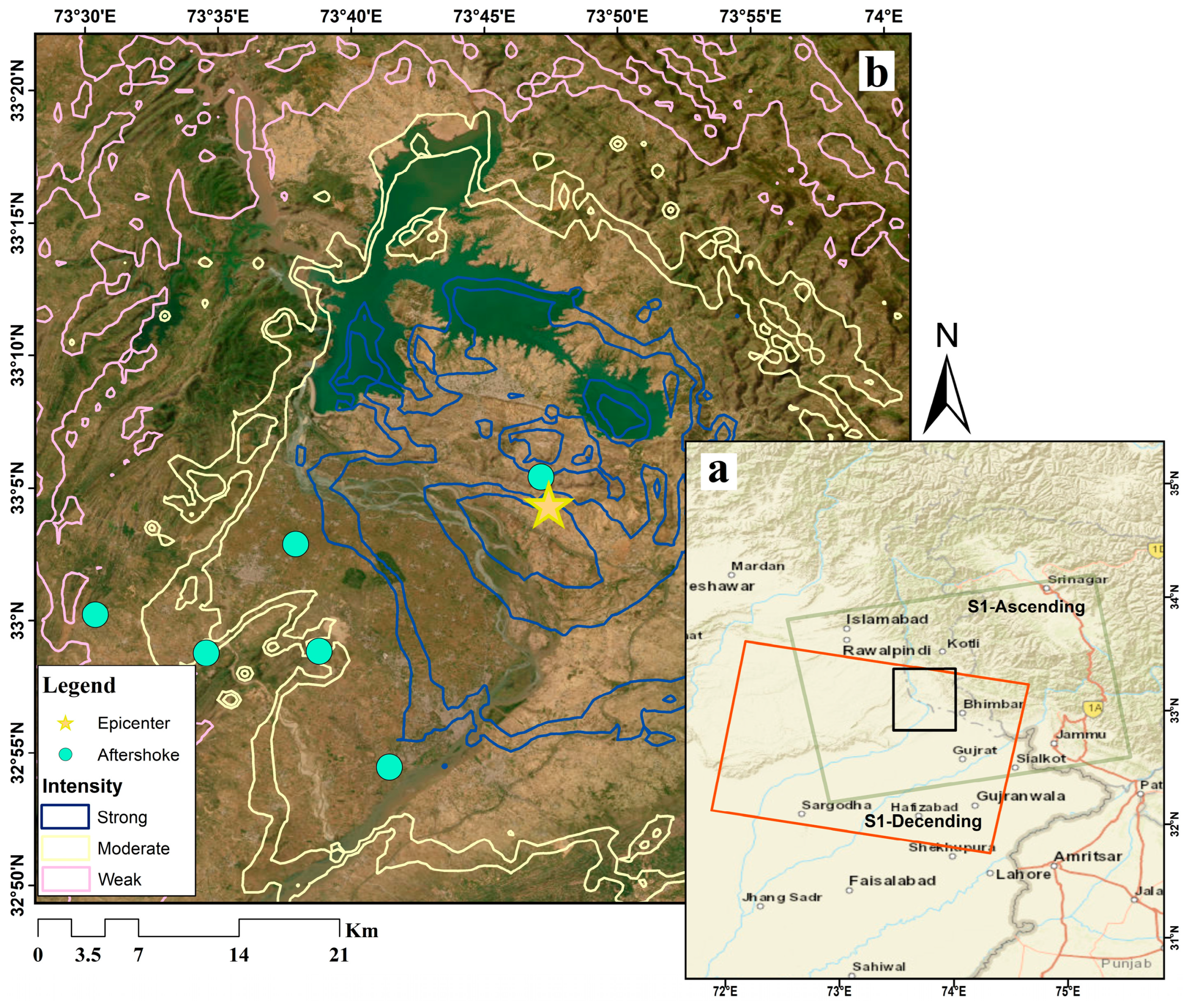

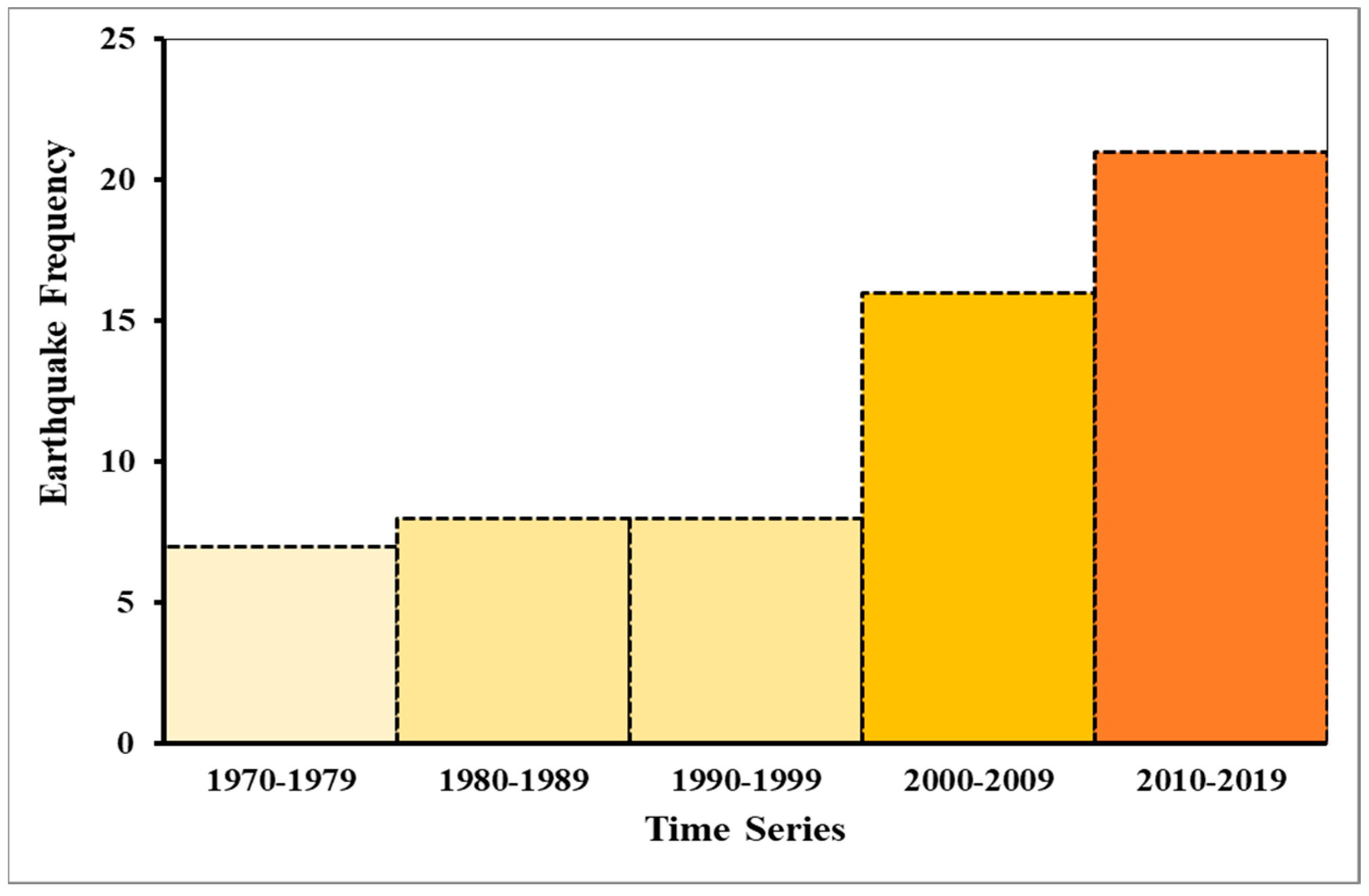
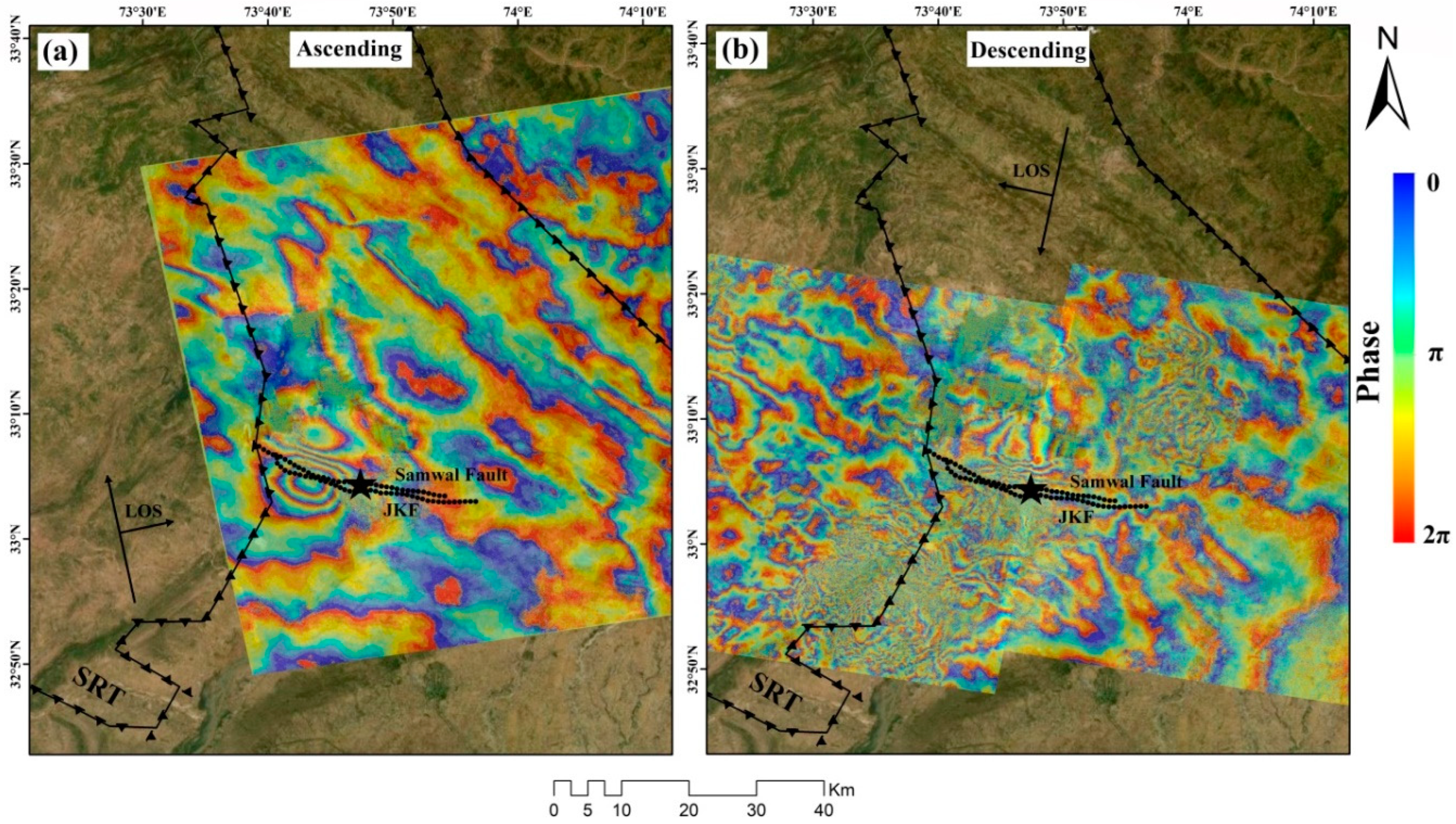
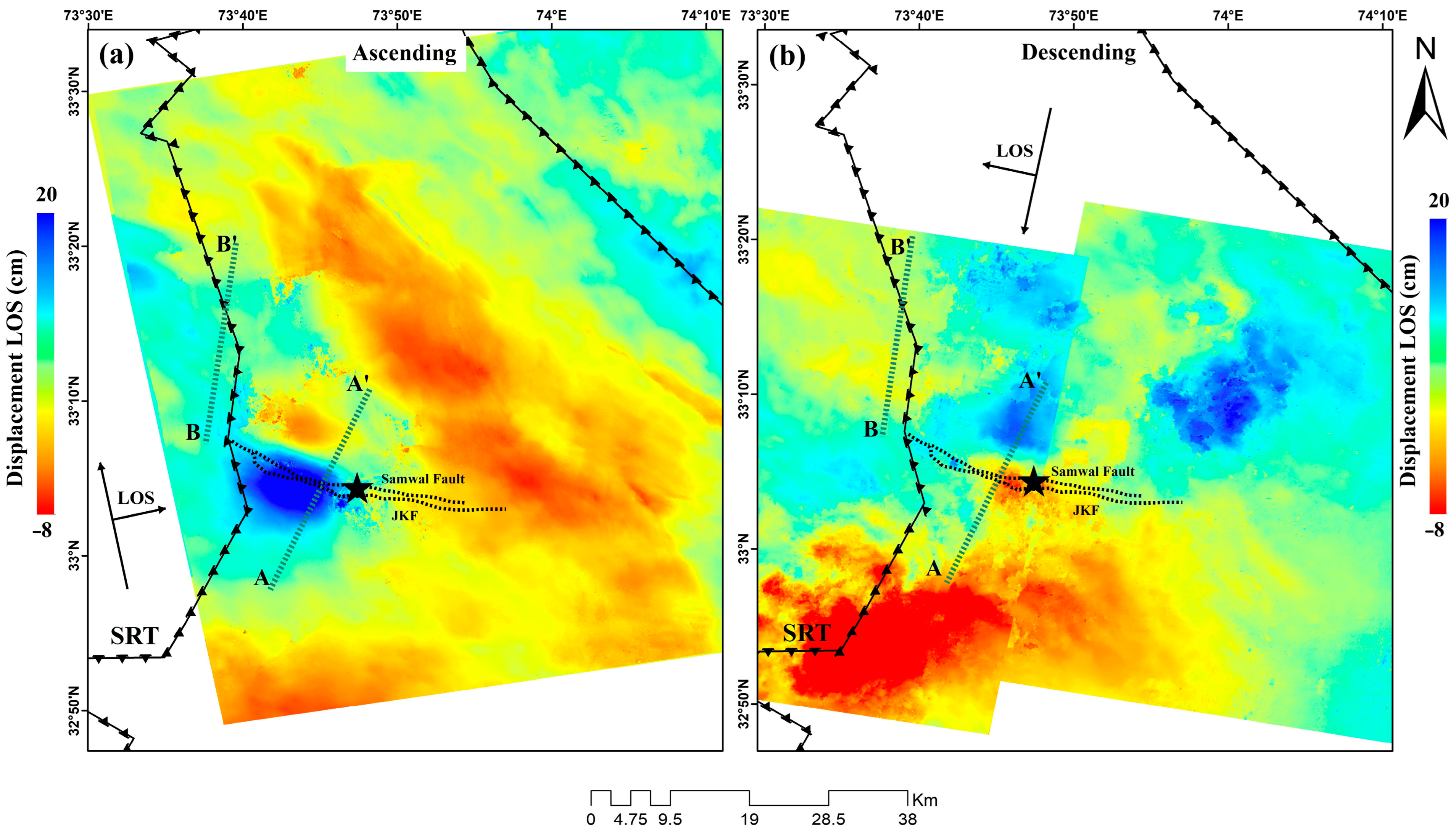

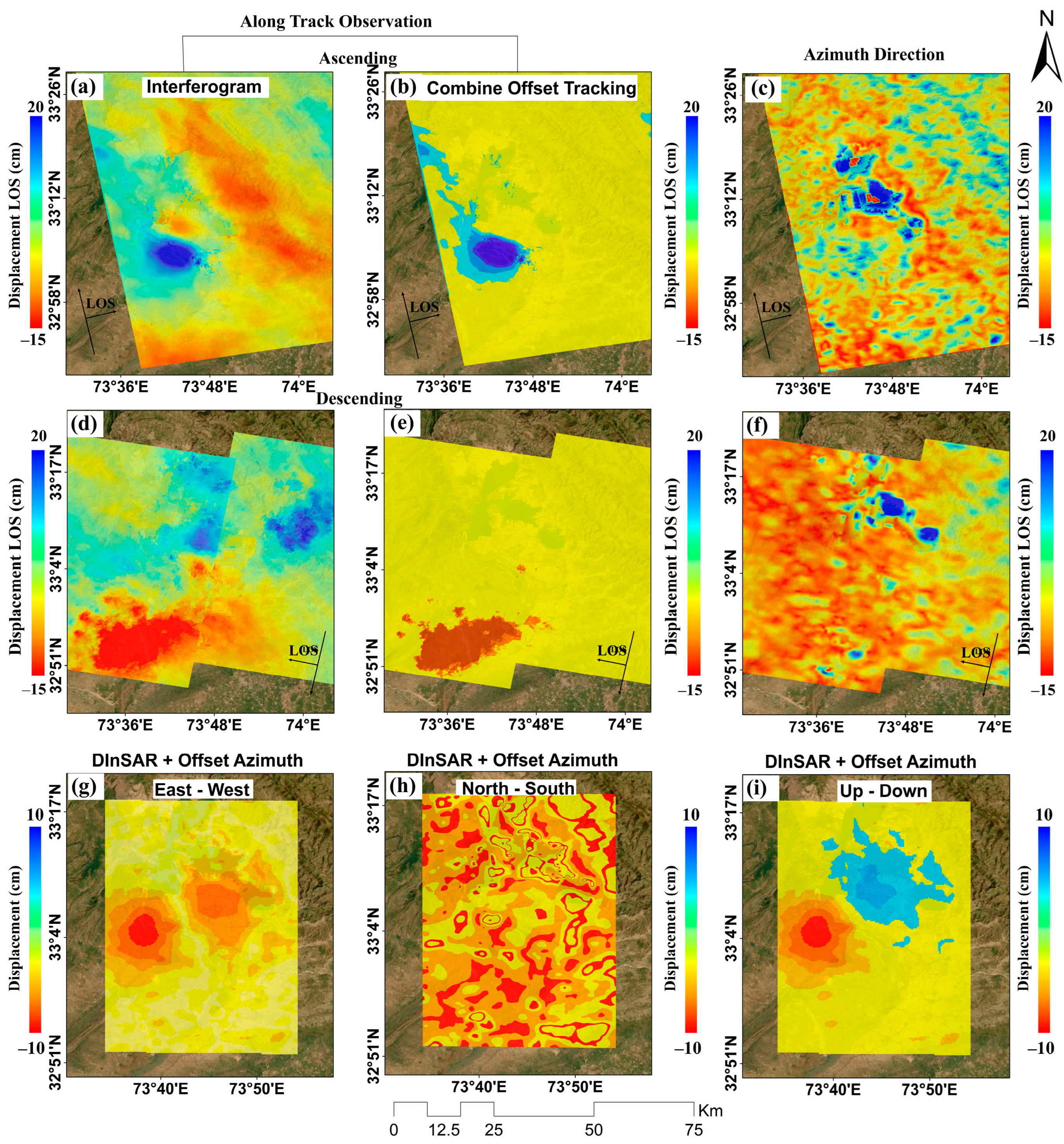
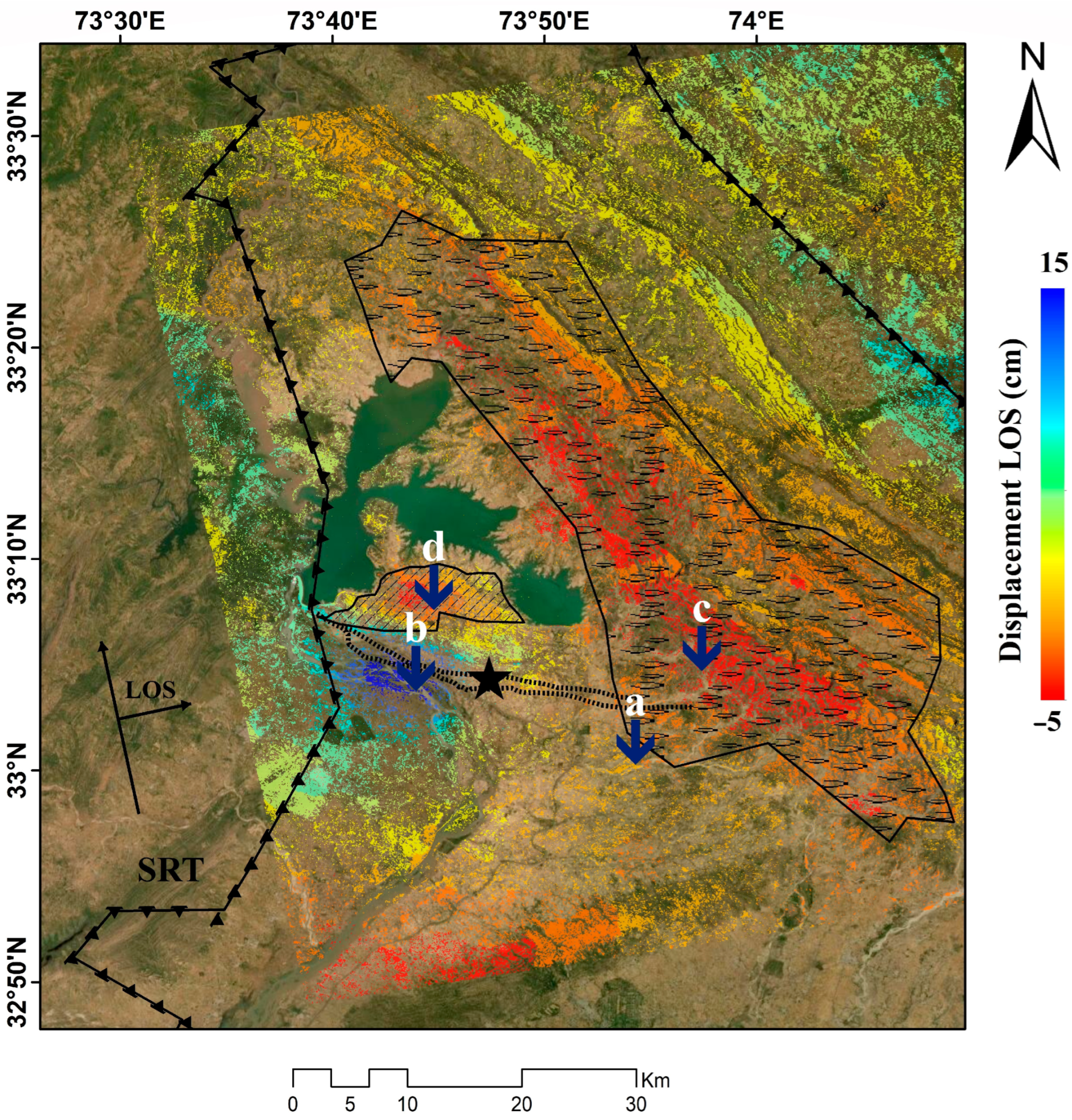
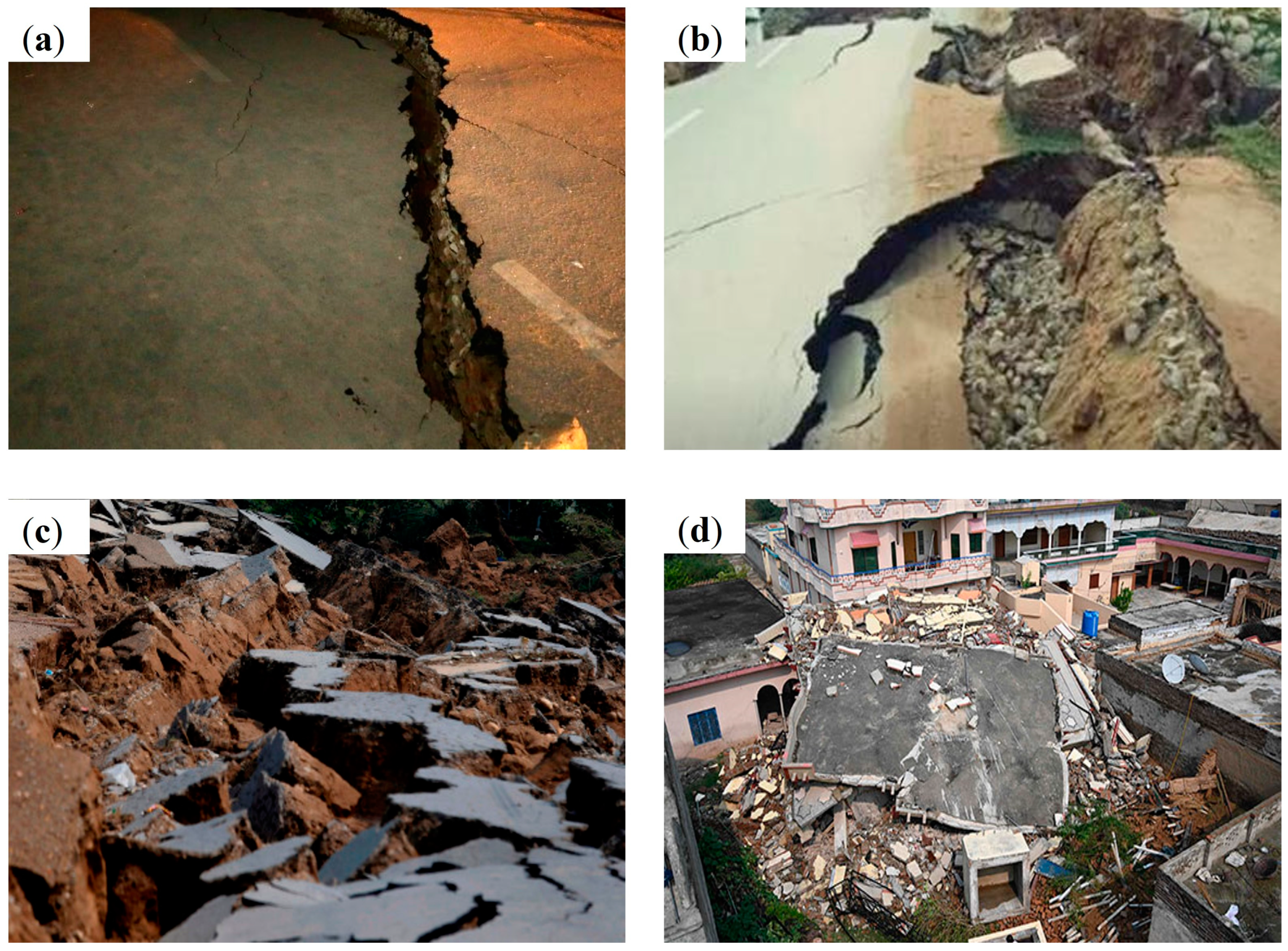


| Sr. No. | Pair’s Acquisition Dates | Datasets | Track | UTC Time | Baseline (m) | Time Span (Days) |
|---|---|---|---|---|---|---|
| 1 | 11 August 2019 23 August 2019 | Pre-seismic | Ascending | 04:41 | −120.18 | 12 |
| 2 | 23 August 2019 4 September 2019 | Ascending | 13:04 | 46.85 | 12 | |
| 3 | 4 September 2019 16 September 2019 | Ascending | 13:04 | 92.33 | 12 | |
| 4 | 16 September 2019 28 September 2019 | Co-seismic | Ascending | 05:42 | −45.87 | 12 |
| 5 | 17 September 2019 29 September 2019 | Descending | 15:28 | 150.60 | 12 | |
| 6 | 28 September 2019 10 October 2019 | Post-seismic | Ascending | 15:23 | −57.86 | 12 |
| 7 | 10 October 2019 22 October 2019 | Ascending | 15:23 | −32.28 | 12 |
Disclaimer/Publisher’s Note: The statements, opinions and data contained in all publications are solely those of the individual author(s) and contributor(s) and not of MDPI and/or the editor(s). MDPI and/or the editor(s) disclaim responsibility for any injury to people or property resulting from any ideas, methods, instructions or products referred to in the content. |
© 2024 by the authors. Licensee MDPI, Basel, Switzerland. This article is an open access article distributed under the terms and conditions of the Creative Commons Attribution (CC BY) license (https://creativecommons.org/licenses/by/4.0/).
Share and Cite
Ali, M.; Schirinzi, G.; Afzal, Z.; Budillon, A.; Mughal, M.S.; Hussain, S.; Ferraioli, G. Estimation of Co-Seismic Surface Deformation Induced by 24 September 2019 Mirpur, Pakistan Earthquake along an Active Blind Fault Using Sentinel-1 TOPS Interferometry. Remote Sens. 2024, 16, 1457. https://doi.org/10.3390/rs16081457
Ali M, Schirinzi G, Afzal Z, Budillon A, Mughal MS, Hussain S, Ferraioli G. Estimation of Co-Seismic Surface Deformation Induced by 24 September 2019 Mirpur, Pakistan Earthquake along an Active Blind Fault Using Sentinel-1 TOPS Interferometry. Remote Sensing. 2024; 16(8):1457. https://doi.org/10.3390/rs16081457
Chicago/Turabian StyleAli, Muhammad, Gilda Schirinzi, Zeeshan Afzal, Alessandra Budillon, Muhammad Saleem Mughal, Sajid Hussain, and Giampaolo Ferraioli. 2024. "Estimation of Co-Seismic Surface Deformation Induced by 24 September 2019 Mirpur, Pakistan Earthquake along an Active Blind Fault Using Sentinel-1 TOPS Interferometry" Remote Sensing 16, no. 8: 1457. https://doi.org/10.3390/rs16081457





